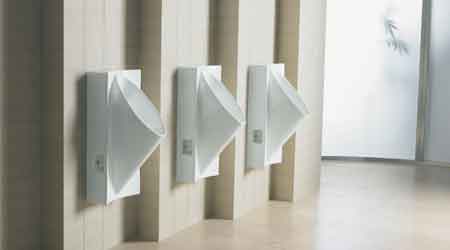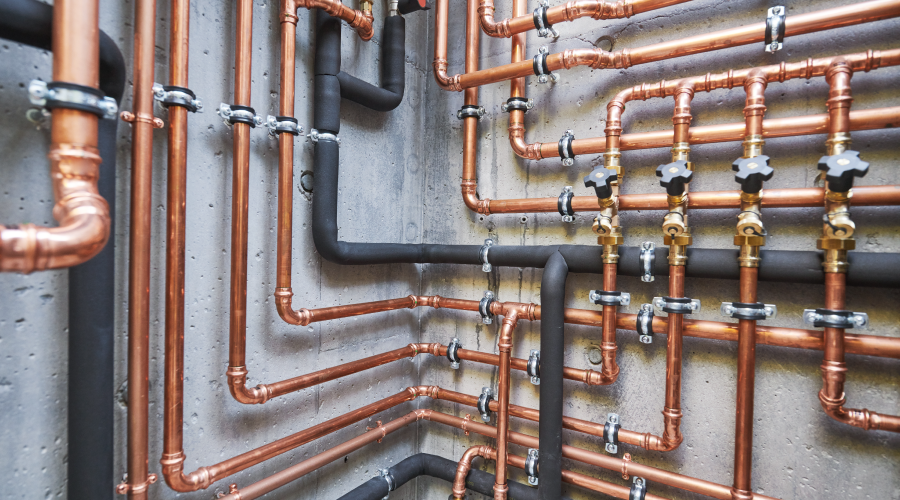New-Generation Advances in Waterless Urinals
Part 3 of a 6-part article on waterless urinals
The design of waterless urinals is similar to that of flush urinals, as both are made of vitreous china or porcelain. Where they differ is that most waterless units rely on a liquid sealant that creates a barrier between liquid waste and the urinal bowl, helping to reduce odors — among the most common concerns for managers and building occupants about the technology.
Waterless models also require a cartridge or an integrated drain trap to eliminate odor issues. The cartridges are disposable, fit into the urinal base, and are easy to insert and remove. An integrated trap model uses the liquid sealant that separates waste from the urinal bowl. First-generation waterless urinals did not differ much from traditional urinals.
“When they were first introduced, many companies simply adapted the basic concept of using urine as the liquid barrier and a low-specific-gravity sealant to isolate it from the environment,” Lawringer says. “As the demand for this type of urinal rose, designs did not change much.
“For companies that were dedicated to the water-conservation movement, design improvements were made based on customer feedback. For instance, the addition of internal baffles and reduced surface area of sealant minimized the loss of sealant when buckets of water inadvertently rinsed it away, allowing odors to escape.
“Other changes were made to the cartridge, such as the addition of a flexible spout where concentrated urine exits the urinal, which increases the velocity as it is redirected through the drain, reducing buildup that can occur in this area.”
Proponents of waterless urinals challenge two major myths surrounding the units.
“The two biggest myths about waterfree urinals are that they are not hygienic and that they smell bad,” Lawringer says. “It is understandable that people think a waterfree urinal can’t be cleaned without using water because we use water to clean just about everything else, from cars to clothes to hands and, of course, to flush. However, studies have shown that the bacteria that are present in urine must have water to survive and multiply.
“Without water, bacteria die quickly. These studies show that a waterfree urinal is up to five times cleaner than a conventional urinal. For that same reason, waterfree urinals produce less odor.”
Managers specifying new-generation waterless urinals also must take the necessary steps to train housekeeping crews on the proper cleaning methods. The training also must emphasize to cleaning crews that simply dumping large amounts of water down the urinals will not keep the urinals their cleanest, nor is the practice considered effective care. Regular cleaning should include wipedowns with a mild cleaner to help extend the life of sealant.
“A properly maintained waterless urinal will function as designed,” says Bob Carter with Zurn Industries. “You have to use care not to dump large amounts of water down a waterless urinal. If you have a large amount of water poured down there, you could evacuate some of the sealant and shorten the life of the unit.
“What some folks don’t realize is that some of the cleaners on the market can break down the sealant and also shorten the life of the unit. There’s a special non-ionic cleaner readily available that will not break down the sealant.”
Because waterless urinals require different cleaning techniques than traditional flush urinals, manufacturers recommend that housekeeping staffs go through training sessions on proper care for the units.
“We have facilities throughout the country that have 110 waterless urinals in them, and they have a tenured cleaning staff that came to our facility, conducted training, and videotaped the training so that any new maintenance cleaning staff that comes on board can watch it,” Carter says. “They are 100 percent committed to making that function work.”
Emphasizing the differences between cleaning a traditional and waterless urinal to a cleaning staff can help add years of life to the units.
“The one thing that’s probably not intuitive is if someone doesn’t realize that this urinal doesn’t set a maintenance precedent, they might just come in and dump a few gallons of water in and walk away,” Scott says.
Related Topics:

















